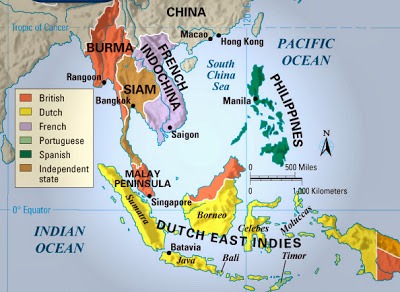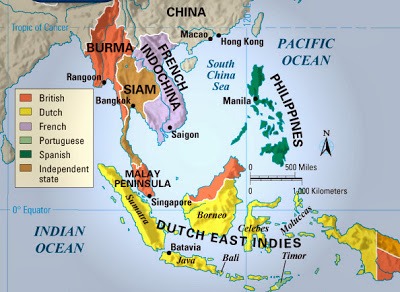Aunque normalmente nos referimos al Sudeste Asiático como si se tratase de un conjunto homogéneo de estados con características similares, la realidad es totalmente contraria a esa idea, y cada uno de los países que lo componen tiene sus propias particularidades. Así pues, a la hora de hablar de nacionalismo, colonialismo, independencia y etnicidad, a pesar de que todos los países de la región, a excepción de Tailandia, han sufrido el colonialismo europeo, en cada uno de ellos ha ocurrido de forma distinta, y el camino para la independencia seguido por cada uno de ellos también ha sido diferente del resto. Mientras países como Filipinas, Myanmar o Malasia finalmente consiguieron su independencia a partir de negociaciones[1], en otros como Indonesia o Vietnam se tuvo que llevar a cabo una guerra para conseguirla[2]. Además, la diversidad étnica que encontramos en la región también es muy importante, ya que su gran variedad, no sólo lingüística, sino también política y religiosa[3], jugó un importante papel en el proceso de independencia de estos países dotando a cada uno de ellos de sus propias particularidades. De este modo, no es posible dar una respuesta categórica a la pregunta inicial, sino que se tendría que analizar el caso de cada país de forma individual. No obstante, también podemos encontrar características comunes en todos ellos tal y como pasaré a explicar a continuación.
* English Version follows the Spanish one.
Una de las características comunes en todos los países colonizados del Sudeste Asiático la podemos encontrar en el nacimiento del sentimiento nacionalista, el cual no apareció hasta la llegada de los colonos europeos. Es más, las fronteras entre los países que forman la región, tal y como las conocemos actualmente, no existían como tal, sino que éstas son una creación europea. A su vez, aunque encontramos casos como el de Tailandia o Vietnam que fueron territorios unificados por dinastías autóctonas, en el caso de otros países como Malasia o Indonesia, hoy en día no los conoceríamos como tal de no ser por la creación de estados coloniales como la “British Malaya” o la “Dutch East India”, ya que hasta entonces eran pequeños estados independientes sin relación con los demás. Así pues, tras su colonización, se limitaron sus fronteras dando lugar a la configuración que encontramos hoy en día. Incluso en el caso tailandés, a pesar de su independencia, sus fronteras también se vieron afectadas por el colonialismo europeo, ya que parte de su territorio lo tuvo que ceder a la “Indochina Francesa” con tal de no entrar en conflicto y poder mantener su status independiente. De este modo, tras la llegada colonial y el menosprecio por parte de sus colonizadores, nació el sentimiento nacionalista que les llevaría a iniciar el camino hacia la independencia de estos nuevos países hasta el momento inexistentes.
Sin embargo, resulta paradójico que en muchos casos el nacimiento de este sentimiento, así como la búsqueda de la independencia, fue altamente influido por el pensamiento europeo, adquirido por los colonizados a partir de la educación que les proporcionaban sus propios colonizadores. Por ejemplo, un personaje clave para la independencia de Filipinas tras la colonización española fue José Lizar[4]. Tras ir a Manila a recibir educación europea, posteriormente viajó a España donde siguió formándose para luego regresar a Filipinas e iniciar el movimiento reformista. Otro ejemplo lo vemos en Myanmar, con U Ottawa[5], adoptando un pensamiento nacionalista tras su formación en el Reino Unido, el país por el cual estaban colonizados. A su vez, lo vemos en las colonias holandesas y francesas. En el caso de Indonesia los principales precursores por el movimiento de independencia fueron jóvenes indonesios que estudiaban en Holanda, donde crearon la asociación Indonesische Vereniging. En cuanto a Vietnam, el famoso líder vietnamita conocido como Ho Chi Minh, viajaría a París, donde se alistaría en el Partido Comunista Francés, para posteriormente colaborar con la Komintern tras su regreso a Asia. Además, incluso en la Revolución Tailandesa, a pesar de que el país no fue colonizado, los ideales democráticos de algunos de sus líderes también provenían de las enseñanzas recibidas en Francia. Así pues, se puede afirmar que si bien antes del siglo XVI d.C. las influencias culturales procedentes de China y de la India fueron fundamentales en la región, a partir de la época colonial el pensamiento europeo también pasaría a ser determinante en la evolución de estos países.
No obstante, lo que más llama la atención en el nacionalismo y los procesos hacia la independencia de los países del Sudeste Asiático no es la influencia europea, sino los orígenes de algunos de sus protagonistas. Si miramos la definición de nacionalismo en el diccionario de la Real Academia Española[6] nos encontramos como primera acepción “Apego de los naturales de una nación a ella y a cuanto le pertenece”, además de “Aspiración o tendencia de un pueblo o raza a tener una cierta independencia en sus órganos rectores”. Sin embargo, en el caso que nos ocupa, se puede ver como la etnicidad y los orígenes de uno no guardaban relación con el sentimiento de pertenencia ni con la búsqueda de la independencia. Por ejemplo, en el caso de los héroes nacionales de Filipinas, tanto Jose Lizar, como Emilio Aguinaldo[7], eran descendientes de familias chinas provenientes de Fujian. Otros casos más extraños los encontramos en Indonesia. Uno de ellos es el de Ernest Douwee, de padre holandés y de madre mitad alemana mitad javanesa. A pesar de su 75% de sangre europea frente al 25% javanesa, fue el fundador del Indische Party[8]. Mientras que Luo Fu-Hsing, nacido en Batavia[9], de padre chino y madre portuguesa, participó en el movimiento anti-japonés de Taiwán, donde está considerado un héroe nacional. Otro caso paradójico lo encontramos en Malaya (parte de la actual Malasia), en la que los propios malayos, tras la rendición de Japón que estuvo ocupando su territorio durante la Segunda Guerra Mundial, no querían convertirse en un país independiente, sino que querían seguir formando parte de la “British Malaya”. De este modo, pretendían evitar la creación de una nacionalidad de la que también formarían parte el 40% de los chinos y el 10% de los hindúes que habitaban en su tierra, ya que al tratarse de inmigrantes no consideraban justo que éstos disfrutasen de los mismos derechos. Así que fueron los chinos e hindúes los que llevaron a cabo el camino hacia la independencia del país. Por último, también quiero destacar los casos de Vietnam y de Myanmar. En el primero de ellos, el intelectual e independentista vietnamita Phan Chau Trinh, consideraba que el camino para la independencia requería de la creación de una nueva cultura, distinta a la existente hasta el momento, lo cual llama la atención si lo comparamos con los movimientos independentistas europeos en los cuales de lo que se trata es de preservar la propia cultura. En cuanto a Myanmar, también podemos ver como la etnicidad tampoco era decisiva para el nacionalismo y su camino hacia la independencia, pues el propio Aung San[10], de etnia birmana, consideraba que el primer paso para la independencia era la creación de una federación junto a otras minorías étnicas que habitaban en la “British Burma”. Así pues, resulta imposible dar una respuesta clara sobre qué es el nacionalismo, así como atribuirle una relación directa con la etnia de uno mismo tal y como lo define el diccionario, pues en el caso del Sudeste Asiático parece que poco tiene que ver con la etnicidad y el lugar del que uno proceda.
* Si te ha gustado la publicación y crees que le puede interesar a alguien, por favor, compártela! También puedes dejar un comentario más abajo, así como seguirme en mi Blog, en Twitter o en mi página de noticias en facebook! Muchas gracias!
- Fuentes de Información:
Todos los datos han sido recogidos durante el curso Introduction to Modern Southeast Asia: History and Archaeology impartido por el profesor Sakai Takashi (坂井隆) en la National Taiwan University entre Septiembre del 2013 y Enero del 2014
- Bibliografía Recomendada:
Osborne, Milton (2010) Southeast Asia: An Introductory History.
[1] A pesar de algunos conflictos, se considera que éstas fueron pacíficas en mayor medida.
[2] En el caso de Laos y Camboya, el proceso de independencia también se llevó a cabo a partir de negociaciones, sin embargo en estas también tuvo una importante influencia la guerra de Vietnam.
[3] Hinduista, Budista, Cristiana, Confuciana, Cao Dai (religión sincrética vietnamita) o Islam entre otras.
[4] Líder del movimiento reformista filipino para conseguir los mismos derechos que los españoles. Tras ser asesinado, el sentimiento independentista anticolonial pasó a ganar mucha fuerza.
[5] Fundador de la asociación independentista Young Men’s Buddhist Association (YMBA).
[6] Diccionario de la Real Academia Española URL= http://lema.rae.es/drae/?val=nacionalismo
[7] Personaje clave en la Revolución Filipina. A pesar de su origen chino, no quería una Filipinas como parte de China, sino como un país libre e independiente.
[8] Partido anti-holandés e independentista de Indonesia.
[9] Actual Yakarta, capital de Indonesia.
[10] Comandante del Ejército Independiente Birmano y presidente de la Liga Antifascista por la Libertad de los Pueblos (AFPFL).
South East Asia: nationalism, colonialism, independence and ethnicity
WHAT IS THE RELATION BETWEEN NATIONALISM, COLONIALISM,
INDEPENDENCE AND ETHNICITY IN SOUTHEAST ASIA?
Although we usually refer to South East Asia as if it was a homogeneous set of states with similar characteristics, the reality is quite contrary to this idea, and each of the constituent countries has its own features. So when talking about nationalism, colonialism, independence and ethnicity, although all the countries of the region, with the exception of Thailand, have suffered European colonialism, in each one of them it happened differently, and their paths followed to the independence have been different from the rest too. While countries like the Philippines, Myanmar and Malaysia finally got their independence from negotiations[1], in other like Indonesia or Vietnam had to carry out a war to get it[2].In addition, the ethnic diversity found in the region is also very important because its great variety, not only linguistic, but also political and religious[3], played an important role in the independence of these countries providing each of them with its own particularities. Thus, it is not possible to give a categorical answer to the initial question, but would have to examine the case of each country individually. However, we can find some common features in all of them as I’ll explain below.
One of these common features in all colonized Southeast Asian countries can be found in the birth of nationalist sentiment, which did not appear until the arrival of the European settlers. Moreover, the borders between the countries forming the region, as we know them today, did not exist as such, but they are an European creation. In turn, although we find cases like Thailand or Vietnam whose territories were unified by native dynasties, in the case of other countries such as Malaysia or Indonesia, today we could not know them as such without the creation of colonial states as the «British Malaya» or the «Dutch East Indies«, because until then were a plenty of small independent states without relation with others. So, after colonization, its borders were limited giving rise to the current geographical configuration. Even in the Thai case, despite its independence, its borders were also affected by European colonialism, as part of its territory it had to yield to the «French Indochina» to do not have conflicts and to maintain their independent status. Thus, after the colonial arrival and contempt by their colonizers, was born nationalist sentiment that would lead them to start the road to independence of these new countries.
Notwithstanding, it is paradoxical that in many cases the birth of this feeling, and the quest for independence, was highly influenced by European thought, acquired by the colonized from the education provided by their own colonists. For example, a key figure for the independence of the Philippines after the Spanish colonization was José Lizar[4]. After going to Manila to receive European education, he travelled to Spain where he continued his training and then returned to the Philippines starting the reformist movement. Another example is seen in Myanmar, with U Ottawa[5] adopting a nationalist thought after his training in the United Kingdom, the country from which they were colonized. In turn, we see it in the Dutch and French colonies. In the case of Indonesia the main precursors for the independence movement were young Indonesians studying in the Netherlands, where they created and association called Indonesische Vereniging. Regarding Vietnam, the world known Vietnamese leader called Ho Chi Minh travelled to Paris, where he enrolled the French Communist Party, and collaborated with the Komintern after his return to Asia. Moreover, even in the Thai Revolution, even though the country was not colonized, the democratic ideals of some of its leaders also came from the teachings received in France. Thus, it can be said that while before the 16th century AD the cultural influences from China and India were instrumental in the region, from the colonial era, the European thought would also become essential in the evolution of these countries.
Nonetheless, what is most striking about nationalism and the process towards independence of the countries of Southeast Asia is not the European influence, but the origins of some of its protagonists. If we look at the definition of “nationalism” in the dictionary edited by the Royal Spanish Academy[6] we find as first meaning «Affection of the naturals of a nation to it and all of its belongings”, in addition to «Aspiration or tendency of a people or race to have certain independence in their governing bodies”. Nevertheless, in the present case, it can be seen as ethnicity and origins of one are not always related to the sense of belonging and the quest for independence. For example, in the case of the national heroes of the Philippines, both Jose Lizar and Emilio Aguinaldo[7] were descendants of Chinese families from Fujian. Other strangest cases are found in Indonesia. One of them is Ernest Douwee, whose father was Dutch and his mother a half German a half Javanese. Despite its 75% of European blood versus 25% Javanese, he was the founder of the Indische Party[8]. While Luo Fu-Hsing, born in Batavia[9], from Chinese father and Portuguese mother, participated in the anti-Japanese movement of Taiwan, where he is considered a national hero. Another paradoxical case is found in Malaya (a part of the nowadays Malaysia), in which the Malays themselves, after the surrender of the Japanese army who was occupying their territory during the Second World War, did not want to become an independent country, but wanted to continue being part of the «British Malaya”, trying to prevent the creation of a Malaysian nationality which the 40% of Chinese and 10% of Indians who lived in the land would form part too, because they considered it was not fair that the immigrants have the same rights of natural from Malaya people. So, the Chinese and the Indians were who carried out the road to independence.
Finally, I also want to highlight the cases of Vietnam and Myanmar. In the first one, the independentist Vietnamese educator Phan Chau Trinh, considered that the way for the independence required the creation of a new culture, different from the existing one, which is striking if it is compared with the independent European movements where one of the main purposes of them is to preserve their own cultures. As for Myanmar, we can also see how ethnicity was not decisive for nationalism and its road to independence, because the ethnic Burmese Aung San [10] considered that the first step towards the independence was the creation of a federation between the Burmish and the other ethnic minorities living in the “British Burma”. So, it is therefore impossible to give a clear answer on what is nationalism and attributing a direct relation with the ethnics or races as defined by the dictionary, inasmuch as in the case of Southeast Asia it seems that it has little to do with ethnicity and the natural place where the people or their families were born.
Isma Ruiz, http://approachingtotheeast.blogspot.com.es/
*All data were collected during the course Introduction to Modern Southeast Asia: History and Archaeology taught by Professor Takashi Sakai (坂 井 隆) at the National Taiwan University between September 2013 and January 2014.
*Recommended Reading:
Osborne, Milton (2010) Southeast Asia: An Introductory History.
[1] Despite some conflicts, it is considered that these were peaceful negotiations.
[2] In the case of Laos and Cambodia, the independence process was also carried out from negotiations, but these were influenced by the Vietnam War too.
[3] Hinduist, Buddhist, Christian, Confucian, Islam, Cao Dai (Vietnamese syncretic religion) or among others.
[4] Leader of the Philippine reformist movement to achieve the same rights as Spaniards. After being killed, the anticolonial independence sentiment won a lot of force.
[5] Founder of the independentist Young Men’s Buddhist Association (YMBA).
[6] Diccionario de la Real Academia Española URL= <http://lema.rae.es/drae/?val=nacionalismo> (Dec 27th, 2013)
[7] Key Player in the Philippine Revolution. Despite his Chinese origins, he didn’t want the Philippines as a part from China, but as a free and independent country.
[8] Anti Dutch Independentist Party of Indonesia.
[9] Actual Yakarta, capital of Indonesia.
[10] Chairman of the Anti-Fascist People’s Freedom League (AFPFL).








31 ideas sobre “Sudeste Asiático: ¿Qué relación existe entre nacionalismo, colonialismo, independencia y etnicidad?”
Ola
Podrias porfavor enviarme a mi correo el word con las 900 preguntas.
mi correo es: mayrapantojazapana@hotmail.com
Porfaaaaaa!: